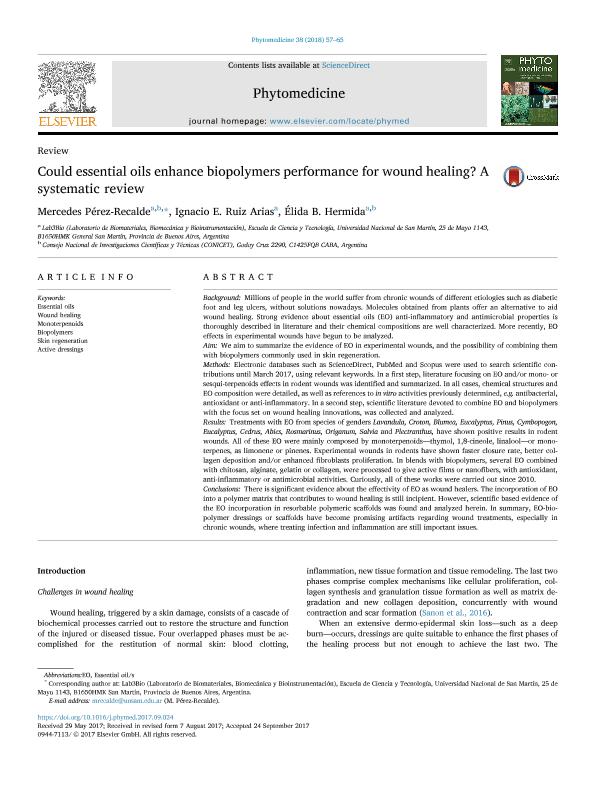Mostrar el registro sencillo del ítem
dc.contributor.author
Perez Recalde, Maria Mercedes

dc.contributor.author
Ruiz Arias, Ignacio Edgardo

dc.contributor.author
Hermida, Elida Beatriz

dc.date.available
2020-01-06T20:48:21Z
dc.date.issued
2018-01
dc.identifier.citation
Perez Recalde, Maria Mercedes; Ruiz Arias, Ignacio Edgardo; Hermida, Elida Beatriz; Could essential oils enhance biopolymers performance for wound healing? A systematic review; Elsevier Gmbh; Phytomedicine; 38; 1-2018; 57-65
dc.identifier.issn
0944-7113
dc.identifier.uri
http://hdl.handle.net/11336/93720
dc.description.abstract
Background Millions of people in the world suffer from chronic wounds of different etiologies such as diabetic foot and leg ulcers, without solutions nowadays. Molecules obtained from plants offer an alternative to aid wound healing. Strong evidence about essential oils (EO) anti-inflammatory and antimicrobial properties is thoroughly described in literature and their chemical compositions are well characterized. More recently, EO effects in experimental wounds have begun to be analyzed. Aim We aim to summarize the evidence of EO in experimental wounds, and the possibility of combining them with biopolymers commonly used in skin regeneration. Methods Electronic databases such as ScienceDirect, PubMed and Scopus were used to search scientific contributions until March 2017, using relevant keywords. In a first step, literature focusing on EO and/or mono- or sesqui-terpenoids effects in rodent wounds was identified and summarized. In all cases, chemical structures and EO composition were detailed, as well as references to in vitro activities previously determined, e.g. antibacterial, antioxidant or anti-inflammatory. In a second step, scientific literature devoted to combine EO and biopolymers with the focus set on wound healing innovations, was collected and analyzed. Results Treatments with EO from species of genders Lavandula, Croton, Blumea, Eucalyptus, Pinus, Cymbopogon, Eucalyptus, Cedrus, Abies, Rosmarinus, Origanum, Salvia and Plectranthus, have shown positive results in rodent wounds. All of these EO were mainly composed by monoterpenoids—thymol, 1,8-cineole, linalool—or monoterpenes, as limonene or pinenes. Experimental wounds in rodents have shown faster closure rate, better collagen deposition and/or enhanced fibroblasts proliferation. In blends with biopolymers, several EO combined with chitosan, alginate, gelatin or collagen, were processed to give active films or nanofibers, with antioxidant, anti-inflammatory or antimicrobial activities. Curiously, all of these works were carried out since 2010. Conclusions There is significant evidence about the effectivity of EO as wound healers. The incorporation of EO into a polymer matrix that contributes to wound healing is still incipient. However, scientific based evidence of the EO incorporation in resorbable polymeric scaffolds was found and analyzed herein. In summary, EO-biopolymer dressings or scaffolds have become promising artifacts regarding wound treatments, especially in chronic wounds, where treating infection and inflammation are still important issues.
dc.format
application/pdf
dc.language.iso
eng
dc.publisher
Elsevier Gmbh

dc.rights
info:eu-repo/semantics/openAccess
dc.rights.uri
https://creativecommons.org/licenses/by-nc-sa/2.5/ar/
dc.subject
ACTIVE DRESSINGS
dc.subject
BIOPOLYMERS
dc.subject
ESSENTIAL OILS
dc.subject
MONOTERPENOIDS
dc.subject
SKIN REGENERATION
dc.subject
WOUND HEALING
dc.subject.classification
Otros Tópicos Biológicos

dc.subject.classification
Ciencias Biológicas

dc.subject.classification
CIENCIAS NATURALES Y EXACTAS

dc.subject.classification
Otros Tópicos Biológicos

dc.subject.classification
Ciencias Biológicas

dc.subject.classification
CIENCIAS NATURALES Y EXACTAS

dc.title
Could essential oils enhance biopolymers performance for wound healing? A systematic review
dc.type
info:eu-repo/semantics/article
dc.type
info:ar-repo/semantics/artículo
dc.type
info:eu-repo/semantics/publishedVersion
dc.date.updated
2019-12-20T22:52:41Z
dc.journal.volume
38
dc.journal.pagination
57-65
dc.journal.pais
Alemania

dc.description.fil
Fil: Perez Recalde, Maria Mercedes. Consejo Nacional de Investigaciones Científicas y Técnicas; Argentina. Universidad Nacional de San Martín. Escuela de Ciencia y Tecnología; Argentina
dc.description.fil
Fil: Ruiz Arias, Ignacio Edgardo. Consejo Nacional de Investigaciones Científicas y Técnicas; Argentina. Universidad Nacional de San Martín. Escuela de Ciencia y Tecnología; Argentina
dc.description.fil
Fil: Hermida, Elida Beatriz. Universidad Nacional de San Martín. Escuela de Ciencia y Tecnología; Argentina. Consejo Nacional de Investigaciones Científicas y Técnicas; Argentina
dc.journal.title
Phytomedicine

dc.relation.alternativeid
info:eu-repo/semantics/altIdentifier/doi/https://doi.org/10.1016/j.phymed.2017.09.024
dc.relation.alternativeid
info:eu-repo/semantics/altIdentifier/url/https://www.sciencedirect.com/science/article/pii/S0944711317301277
Archivos asociados
